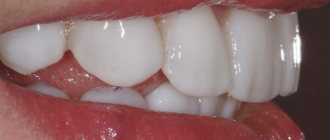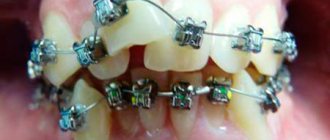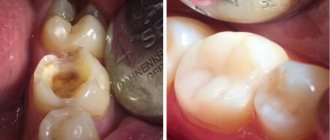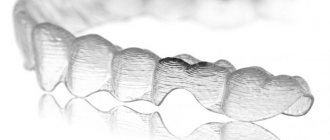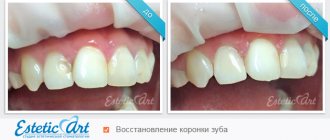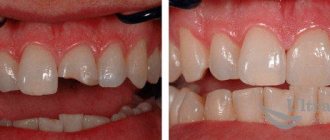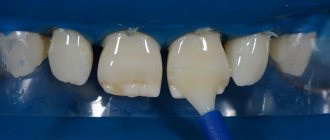Veneers
Ceramic “scales” that are attached to the surface of the teeth after preliminary grinding.
Tabs
Microprostheses made of ceramics.
When working with veneers, artistic restoration of teeth is performed in 3 stages:
- Examination, professional oral hygiene, planning, taking impressions. Modeling future restorations in wax or plastic. At this stage, the doctor and the patient select and adjust the shape and color. Taking high-precision impressions for permanent structures, the impressions are sent to a dental laboratory. Also, at each visit, before fixing permanent restorations, the tooth is processed and closed with a temporary filling.
- Removing the temporary filling. Treatment of the tooth surface. Isolation of dental units from moisture. Drying the surface and fixing the overlay, veneer. Lighting and polishing.
Our clinic uses advanced materials and indirect restoration techniques, which do not always require enamel removal. We use this approach when we detect a diastema, trema, or spaces between teeth in a patient.
The production time for veneers is 7 days.
Service life - 10−15 years.
Aesthetic dental restoration with veneers - advantages and disadvantages
Advantages
- Predictability of the result. Thanks to close cooperation between the doctor, dental technician and patient
- Naturalness. Inlays and onlays are no different from other teeth
- Does not require special care
- Ceramic products prevent the formation of plaque (bacteria cannot cling to a smooth surface)
- They are not afraid of temperature changes, do not darken or wear off over time
Flaws
- Incomplete restoration of chewing functions. We do not recommend eating solid foods
- Relatively high cost (compared to direct restoration)
- Enamel grinding in most cases
What is restoration with composite materials?
Composite light-curing material is one of the most popular when carrying out therapeutic procedures and microprosthetics. So-called composite resins have been used in dentistry for more than half a century, but the composition of the materials has been constantly refined and changed to achieve optimal strength and aesthetics. Today, most clinics use hybrid composites, which are superior to previous generation materials in these indicators. The key property of any composite is excellent adhesiveness (contact of the material with the tooth tissue), which is achieved through polymerization. Simply put, under the influence of ultraviolet light the composite hardens, restoring the anatomical shape of the tooth.
In what cases is it relevant to use?
With the help of composite veneers, you can visually hide only minor defects. These include:
- With age, teeth change color;
- the shape of the incisor has changed (consequences of abrasion or injury);
- enamel pigmentation has occurred that cannot be whitened (pigmented cracks, fluorosis or tetracycline teeth);
- the existence of diastemas or trema;
- slight mixing of teeth in the vertical axis;
- if there is a defect in the filling, but it is stable (for example, the filling material has darkened over time);
- a composite plate can hide defects in an underdeveloped tooth that formed during its development (for example, amelogenesis or hypoplasia);
- in cases of uneven contour of the incisor neck;
Sometimes, with the help of direct composite veneers, it is possible to change the group affiliation of a tooth. An example would be the visual change from a canine to a lateral incisor.
Types of composite restorations
Composite fillings.
Photopolymer, acrylic and epoxy fillings fall under this category. Each of the subtypes has its own advantages, but photopolymer fillings are considered the most versatile and reliable.
Composite tabs.
Used when there is significant damage to a tooth or dentition. Composite inlays have a good price-quality ratio, so they are often offered in clinics.
Composite veneers.
Teeth onlays that restore aesthetics and hide damage.
Today, composite restoration means the installation of veneers from the appropriate material. Despite the fact that in dentistry composites are actively used in therapeutic treatment, composite dental restoration is a rather narrow concept related to aesthetic dentistry. That is why direct veneers fit the category of artistic (aesthetic) restoration.
Composite veneers have almost the same indications and contraindications for installation as ceramic ones. The choice in favor of ceramic products is made in case of more significant chips and curvatures. Ceramic linings are also more aesthetically pleasing and durable.
Indications and contraindications for the manufacture of lumineers
Lumineers (Hollywood veneers, ultra-veneers, nano-veneers) are veneers that do not require grinding of tooth tissue.
General indications for lumineers are similar to those for traditional veneers.
- Minor defects of the crown part of the tooth (chips, enamel cracks, wedge-shaped defects);
- Anomalies in tooth shape;
- Anomalies in the structure of hard dental tissues;
- Change in color of hard dental tissues;
- Relapses after orthodontic treatment (displacement of the central incisors to the sides with the formation of a gap).
General contraindications to the manufacture of lumineers
- Anomalies in the position of the teeth (the thinness of the design will not significantly change the situation);
- Anomalies in the closure of the dentition;
- Non-functional muscle activity and bad habits;
- Significant defect in the coronal part of the tooth (inlays or artificial crowns are shown);
- Acute or exacerbation of the chronic form of inflammatory diseases of the oral cavity (it is impossible to ensure dryness of the field during fixation due to leakage of inflammatory fluid and/or blood);
- Allergic reaction of the patient to any component of the adhesive system;
- Amelogenesis imperfecta (inherited defective structure of hard tissue).
Advantages and disadvantages of dental restoration with composite veneers
- Lower cost compared to ceramic veneers.
- They do not require deep preparation of tooth tissue.
- Good aesthetic indicators (the final result largely depends on the qualifications of the doctor).
- Simple replacement procedure.
- Less strong and durable compared to ceramic veneers.
- They require regular grinding (at least once every six months).
- Over time, dyes are absorbed, which affects aesthetics.
Direct and indirect composite restorations
There are direct and indirect composite restorations. First of all, the methods differ in production technology. The production of direct composite veneers involves carrying out all manipulations in the patient's oral cavity, while indirect restorations require a dental laboratory to produce onlays.
Direct composite dental restoration
Direct composite veneers are created by layering composite material. To install them, there is no need to take impressions, since the restorations are made directly in the patient’s mouth. The stages of dental restoration with composite materials include preparation, layer-by-layer application of the composite, grinding and polishing.
Indirect composite restoration
The indications for indirect composite restoration are exactly the same as for direct veneers, and the production of onlays does not take place on the surface of the teeth, but in the laboratory. Ready-made indirect restorations with composite materials are produced under the Componeer brand.
The advantages of the direct method are its low price and speed of production (all manipulations can be carried out in one procedure). On the other hand, indirect veneers are better in terms of quality, aesthetics and durability.
Research results
The patient, 46 years old, complained of an aesthetic defect in her anterior teeth (Fig. 1). Objectively: in the 11th and 21st teeth, extensive partial restorations with signs of secondary caries and a violation of the marginal seal are determined. The central incisal line is shifted to the left. Pathological abrasion along the cutting edge. Color 21 slightly changed. According to the patient, the tooth darkened after primary endodontics many years ago. After repeated endodontics, the color did not change. The tooth doesn't bother me. The radiograph shows obturation of the canal to the apex, the periodontal fissure is not widened.
Rice. 1. Defects in the fillings of the 11th and 21st teeth.
In accordance with the clinical picture, a diagnosis was made: secondary caries of the 11th and 21st teeth. The patient was informed about alternative methods of orthopedic and therapeutic restorative treatment of anterior teeth. She chose the method of complete direct restoration of 11 and 21, which is consistent with the opinion of the dentist. This choice is justified by the following factors:
- a large volume of lost tooth tissue dictates the need to correct the crown height and color, which excludes partial restoration;
- the relative cheapness of the method, treatment in one visit is attractive for the patient, in contrast to prosthetics or indirect restoration;
- slight color change 21, time and economic factors excluded intracanal bleaching 21.
The patient signed a preliminary consent to perform the necessary manipulations. Teeth were cleaned of plaque mechanically using a product that did not contain fluoride and oil. For this purpose, Clint paste (VOCO) was applied to a special brush rotating at low speeds. To avoid heating the tooth, an excessive amount of paste was used. Then the tooth was thoroughly washed with a stream of water.
Next, the size, shape, and relief were planned, which is a strictly defined sequence of actions, including odontometry and odontoscopy of the central incisors. Based on visual assessment and measurement results, a rectangular crown shape was planned: the side surfaces are located almost parallel; the horizontal dimensions in the middle and lower thirds are close in value.
Evaluation of signs of teeth belonging to the side showed a predominance in size of the distal angle of the crown. The sign of crown curvature is not expressed. The description of the individual characteristics of the tooth consisted of assessing the type of macrorelief of the vestibular surface.
The selection of the desired shades of the Admira Fusion (VOCO) photocurable composite was carried out in natural light using special standards by comparing them with the intact lateral incisor before installing the rubber dam. The color of the composite was specified by applying a “drop” of the composite to the vestibular surface of the incisor directly from a syringe (Fig. 2, 3). The following syringes were selected: cervical region - A3.5, body - A2, transparent enamel - Incisal. The material allows intuitive selection of shades and makes it possible to create colors using both opaque and enamel shades.
Rice. 2. Selection of enamel shades of the composite.
Rice. 3. Selection of dentin shades.
Considering the slight difference in the color of the 11th and 21st teeth, it was decided to carry out a correction using enamel shades of the material. Thus, for the cervical area of the 21st tooth, a syringe GA3.25 was chosen (the original shade between A3 and A3.5 on the Vita scale), and shade A1 was used for the body of the veneer.
The preparation was performed with medium-grain diamond burs and began with the removal of low-quality fillings, protruding enamel edges, and dentin necrotomy (Fig. 4). The contours of the veneer coating were marked using a small spherical bur in the form of grooves no more than 0.5 mm deep.
Rice. 4. A set of burs for preparing a tooth “for veneer”.
In the proximal areas, to hide the edge of the veneer, the boundaries extended to the contact surfaces. The cervical border of the veneer is located along the border with the gum to avoid the transmission of pigmented tooth tissues. Cervical ledges are formed, internal angles are smoothed. The vestibular surface of the incisors was processed with a fine-grained cylindrical bur (Fig. 5, 6).
Rice. 5. Marked bur in sterile packaging.
Rice. 6. A diamond bur is placed in the turbine tip.
A rubber dam was installed with exposed teeth 14 to 24, which will allow you to focus on the dentition when creating the shape and distributing color areas. The quality control of preparations 11 and 21 was carried out (Fig. 7). Next, the technique of total etching of the prepared surfaces of the central incisors was carried out (Fig. 8).
Rice. 7. The central incisors were prepared.
Rice. 8. Total acid etching.
The gel used was Vococid (VOCO) - 35% phosphoric acid. The gel was washed off with a stream of water, and the teeth were dried with a reflected stream of air. Adhesive preparation was carried out with a universal bond, suitable for any adhesive technique (Fig. 9). A thin layer of Futurabond was applied to the etched surface of the teeth with a brush and cured with the light of a halogen lamp (Fig. 10). Next, the veneers were modeled using the following Grandio dentin shades for the 11th tooth: cervical area - color OA3.5, body - OA2 (Fig. 11).
Rice. 9. Futurabond U adhesive system.
Rice. 10. Adhesive preparation of the 11th tooth.
Rice. 11. Photo-curable material.
The production of a classic veneer began with the application of an opaque composite to the prepared surfaces. A restoration base is created that includes a dentin geometric outline to define the lateral and inferior boundaries of the veneer. The sign of the crown angle is modeled. The first layer of Grandio opaque filling material was placed on the mid-gingival area and moved towards the neck of the tooth. The next layer was placed on top of the previous one and distributed evenly over the entire area. The lateral surfaces of the veneer were not brought into contact with adjacent teeth by 1.0 mm, which is due to the type of transparency of the enamel in this area (Fig. 12).
Rice. 12. Opaque layers of the composite are applied.
In accordance with the instructions for using the composite material, the latter was added in layers no more than 2 mm thick, compacted to the tooth tissue and cured with halogen light. The prepared opaque base, which replenishes the shape and volume of the tooth dentin, was covered with enamel shades of the material. To form a periodontal contour, a portion of enamel composite was applied to the central gingival area of the tooth and smoothed from the center to the periphery.
When modeling the enamel layer, shades A3.5 and A2 were used, respectively. Space is left for the transparent Incisal shade in the area of the incisal edge and side edges (Fig. 13). The formation of contact surfaces was completed by applying a transparent composite, which was distributed taking into account the individual degree of transparency of the enamel. The same transparent material was used to model the cutting edge and cover the corners of the veneer.
Rice. 13. Modeling the enamel layer.
For the restoration of the 21st tooth, dentin colors were chosen similarly to veneer 11. Syringes of the enamel composite are presented in shades GA3.25, A1, Incisal (Fig. 14). Dentin shades for the formation of a veneer on the 21st tooth were applied in layers up to 2 mm thick, which ultimately filled the volume of missing dentin without involving the boundaries of the enamel layer (Fig. 15). Using individual tint enamel syringes, the effect of neutralizing color accents was achieved (Fig. 16). The surface of the restoration was covered with a transparent layer in accordance with the type of enamel transparency.
Rice. 14. Tint composite syringe.
Rice. 15. Opaque layer of the 21st tooth.
Rice. 16. Color neutralization has been completed.
Immediately after the aesthetic structure is manufactured, it is processed: the surface hybrid layer is removed and the relief is enhanced. Contouring and polishing of the vestibular surface of the veneer was carried out using Dimanto diamond instruments (VOCO) (Fig. 17). After removing the rubber dam, adaptation to the bite, grinding, and polishing are controlled (Fig. 18).
Rice. 17. Polishing system.
Rice. 18. Ready-made aesthetic restorations.
The final stage of treatment is coating the enamel surrounding the restoration with fluoride-containing varnish Bifluorid 12 (Fig. 19). Long-term quality control of the work performed shows the high efficiency of using the method of producing direct veneers from a photocurable composite.
Rice. 19. Fluoride varnish.
Features of composite restoration of anterior and chewing teeth
Speaking specifically about veneers, aesthetic restoration with composite material is used exclusively for front teeth. The primary task of overlays is to hide cosmetic and anatomical problems, as well as mechanical damage. This is why composite restoration of anterior teeth costs much more than a conventional filling, and many experts even consider the process of making veneers an art.
In the case of chewing teeth, the issue of aesthetics is already less significant: functionality comes to the fore. However, restoration of chewing teeth with composite material makes it possible to restore damaged dental tissues at a high aesthetic level. In this case, it is almost impossible to notice the filling on the tooth. Typically, dentists use macrophilic and hybrid composite materials when filling molars because they are considered stronger and more durable.
